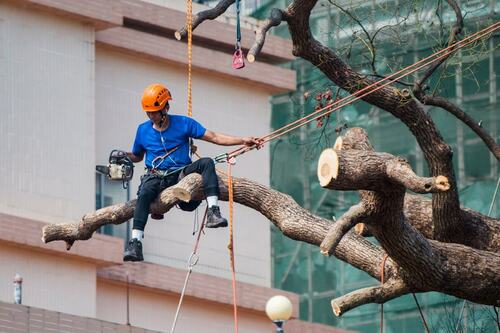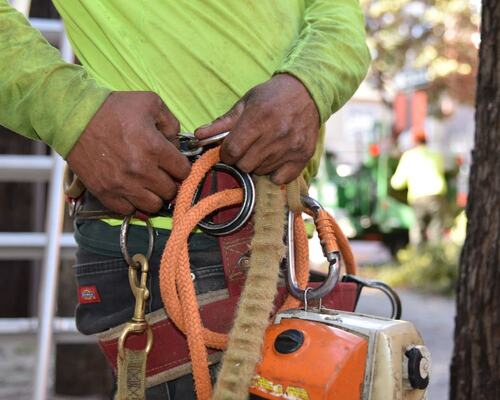The Importance of Personal Protective Equipment (PPE) for Arborists
Introduction
Arboriculture, the practice of managing and maintaining trees, is a profession fraught with risk. As an arborist, you frequently work in hazardous conditions, dealing with heights, heavy machinery, sharp tools, and the unpredictable nature of trees. To ensure your safety and well-being, the use of Personal Protective Equipment (PPE) is essential. Below, you will learn the importance of PPE for arborists .
Head, Face, and Hearing Protection

An Arborist at Work Wearing Proper Gear – Photo by Helena Jankovičová Kováčová
A helmet equipped with a face shield and ear protection is the most crucial piece of PPE for you, safeguarding against head injuries from falling branches, tools, and accidental impacts. The face shield protects your face from debris, sawdust, and splinters, while ear protection prevents long-term hearing damage from the loud noises produced by chainsaws and other machinery.
Certified arborists understand the crucial role of preventative tree pruning in maintaining tree health and safety, but they also recognize that personal safety is paramount. Not using adequate head, face, and hearing protection while working as an arborist can lead to serious injuries and long-term health problems. Without proper head protection, you are at risk of head trauma, concussions, and even fatal injuries from falling objects. The absence of a face shield can result in eye injuries from flying debris, while the lack of ear protection can cause permanent hearing loss due to prolonged exposure to loud machinery.
Eye and Hand Protection

Cutting Large Branches Using Proper PPE – Photo by Jimmy Chan
Understanding and addressing the most common tree issues , such as disease, pest infestations, and structural problems, is a key aspect of an arborist’s job. However, solving these issues effectively requires expertise and personal safety. Without proper eye and hand protection, tackling these tree problems can put you at serious risk.
Protective eyewear, such as goggles or safety glasses, shields your eyes from flying debris and sawdust, preventing potentially permanent vision loss. Cut-resistant gloves are indispensable for protecting your hands from cuts, abrasions, and punctures while handling sharp tools and rough branches. Without cut-resistant gloves, you risk sustaining deep cuts, lacerations, and puncture wounds from sharp tools and rough branches. These injuries can not only be extremely painful but also lead to infections and prolonged recovery times. By wearing cut-resistant gloves, you provide a barrier of protection that significantly reduces the likelihood of hand injuries and ensures your safety while working as an arborist.
Protective Clothing
Chainsaw-protective clothing, including pants, chaps, and jackets, is made from materials designed to clog the chainsaw chain and stop it from rotating, thereby reducing the risk of serious injuries to your legs and upper body. High-visibility clothing ensures you are easily seen by coworkers, especially when working in densely vegetated areas or near roadways, thus reducing the risk of accidents involving moving machinery or vehicles.
Additionally, a hard hat with a chin strap is crucial for protecting your head from falling debris and branches, reducing the risk of head trauma and concussions. Lastly, a full-body harness is necessary when working at heights to prevent falls and ensure your safety while performing aerial tree work.
Footwear and Fall Protection

An Arborist Now Expert Harnesses Up Before Beginning Work
Safety footwear, such as steel-toe boots with nonslip soles, provides protection from falling objects and ensures stability on uneven or slippery surfaces. At the same time, good ankle support prevents sprains and falls. Harnesses provide a secure attachment point for a lanyard, rope, or lifeline, acting as a shock absorber in a fall. Fall-arrest systems consist of a harness, a lanyard, and a shock absorber that work together to stop a fall before it reaches the ground. These systems are essential for any worker working at heights.
Additionally, a full-body harness should always be worn when working at heights. It should fit snugly and be securely fastened, and the straps should be checked regularly for wear or damage.
Additional Essential Tools

The AK 5.5 Outdoor Knife from Architect Knives
An outdoor survival knife is a versatile tool for emergency situations and is a general utility in the field for cutting ropes or preparing wood. It can be used to cut through tangled ropes or straps during a rescue operation, create makeshift shelters, and even for basic first-aid purposes like cutting bandages or removing splinters. Its multifunctionality makes it an indispensable tool for arborists working in potentially hazardous environments.
Protection Against Bacteria and Fungi

Respirators and Ear Protectors Keep Arborists Safe
Working with trees and in natural environments exposes you to various bacteria and fungi that can cause infections. PPE plays a crucial role in minimizing these risks. Wearing gloves and appropriate clothing reduces skin contact with contaminated surfaces, preventing infections such as tetanus or fungal infections like sporotrichosis , which can occur from handling thorny plants or decaying vegetation.
Respirators or masks can also protect you from inhaling mold spores or other airborne pathogens that thrive in damp, decaying wood. By incorporating PPE designed to block exposure to these microorganisms, you can significantly reduce the chances of contracting infections and ensure a healthier working environment.
Conclusion
PPE is vital for you as an arborist, providing essential protection against the inherent dangers of your work. From helmets and gloves to chainsaw-protective clothing, outdoor survival knives, and fall-arrest systems, each piece of PPE plays a critical role in safeguarding your health and security. By prioritizing the use of PPE and adhering to safety regulations, you and your colleagues can minimize risks and create a safer work environment for all professionals involved.
Guest Post: Jordan McDowell is a writer and content strategist. He specializes in technically oriented B2B and B2C content for a number of digital companies.


